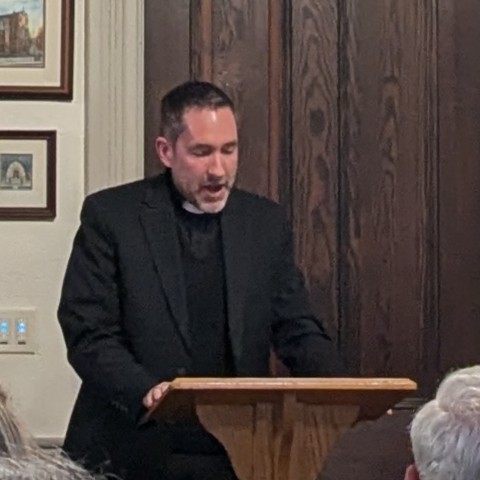
Roughly 70 people met together at St. Mary’s Parish in Lancaster, Pennsylvania on 11 April to initiate a new dialogue between Roman Catholics and Anabaptist-related groups. The number was far more than expected and included not only Mennonites but Brethren, Bruderhof, and Old-Order Amish as well.
Organized by Sean Domencic, a Catholic Worker and lay Franciscan, along with Luke Haldeman, who found inspiration in the Catholic tradition even as he moved from evangelicalism to Anabaptism, the event took place with the encouragement of the Roman Catholic Diocese of Harrisburg. Domencic and Halderman took inspiration from the coincidence of the current Jubilee Year in the Catholic Church and the 500th anniversary of Anabaptism.
The evening began with a light potluck meal and a service of evening prayer that modified a Catholic Vespers liturgy by incorporating a hymn popular with Mennonites, a commentary on nonviolence from Menno Simons, and appropriate antiphons and intercessions. Talks from six different speakers, both Mennonite, Catholic, and “Mennonite Catholic” were limited to five minutes in order to allow for small-group discussion at 11 different tables.

Some tables reported rich in-depth discussions on experiences of conversion and ecclesial initiation; others reported being surprised by basic elements of the other tradition. Some Catholics did not know that Anabaptists were persecuted by the Catholic Church and some Anabaptists did not know that the Pope had formally apologized for these persecutions. There was great interest in further dialogue. Two attendees said they wished there would be “a whole ecumenical weekend.” At least 25 stayed for an extra hour of discussion.
Receiving wide discussion was a vision and desire for an Anabaptist Ordinariate – the kind of administrative structure that has allowed some Anglicans to enter Catholic communion without abandoning their own traditions.
The 11 April dialogue was organized to coincide with an Anabaptist History Conference nearby on the following day. That conference was attended by around 400 people, almost all plain Mennonites/Amish. At least 10 attendees of the dialogue went to the conference. The presence of Catholics at the conference was a great surprise to its Anabaptist organizers and speakers, most of whom were skeptical of the value or possibility of ecumenism.
Nonetheless, many substantive theological conversations occurred at the conference, and some participants there expressed interest in future dialogues. Catholics in attendance had opportunities to correct what they saw as misunderstandings about the teachings of the Catholic Church. To their surprise, a few speakers drew favorably from Catholic traditions – one quoting Thomas Aquinas and another emphasizing repeatedly that the Anabaptist vision of discipleship was essentially “monastic.”
Based on a report by Sean Domencic
